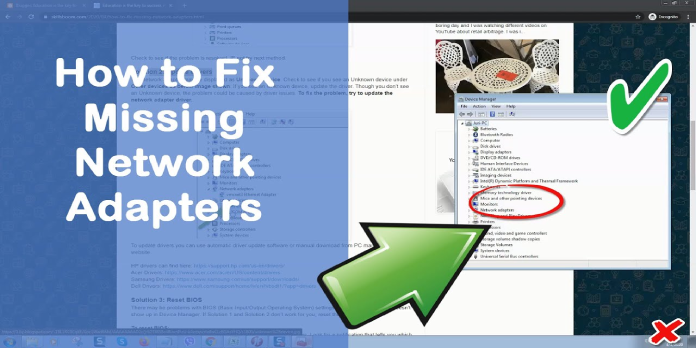Here we can see, “How to: Fix Wireless Drivers Are Missing on Pc”
- You won’t be able to use the Wi-Fi connection or connect to the Internet if the wireless drivers are missing.
- The missing Wi-Fi driver can be manually replaced or replaced with third-party software.
- Try troubleshooting your wireless connection to see if that helps you solve the problem.
- You should also try resetting the Winsock settings with a command-line program. Our tutorial will show you how to do it.
Users have reported that their wireless drivers are missing and that the network adapter on the Taskbar isn’t even active.
This problem can be incredibly aggravating because it can prevent you from accessing the Internet, even if it is operational.
On Microsoft Answers, one user had the following to say about the problem:
The Wireless Adapter isn’t even listed in Device Manager, let alone in the Network and Connections section. The computer merely tells that a network cable must be plugged in for troubleshooting.
Under network connections, there is no wireless option. There is no wireless adapter tab when you right-click Network Adapter in Device Manager. Any assistance is greatly appreciated.
In this article, we’ll look at some of the most effective ways to troubleshoot Wi-Fi driver problems. To learn more, keep scrolling down.
What should I do if my network adapter driver is missing?
1. Examine the hardware for any modifications
- Select Device Manager by pressing the Win+X buttons on your keyboard.
- Select Show hidden devices under the View tab.
- Right-click on the wireless adapter and select Scan for Hardware Changes from the Network Adapters menu.
- Close Device Manager and check if it resolves your problem.
Scanning for hardware changes on your wireless adapter will quickly resolve this issue because the system will identify and resolve any potential faults.
2. Make sure your wireless network driver is up to date
- Select Device Manager by pressing the Windows + X buttons on your keyboard.
- Select Update driver from the context menu of the wireless adapter.
- Select the option to search for updated driver software automatically.
- Allow Windows to find and download the appropriate driver.
Manually updating drivers is a time-consuming and tiresome procedure, and the system’s default driver may not be the best option for your network device.
Alternatively, you may use third-party solutions like the one listed below to automatically update all of your PC’s drivers with just a few clicks.
Old or incompatible drivers are the source of some of the most prevalent Windows issues and malfunctions. Lag, system issues, and even BSoD‘s can occur if your system is out of the current.
3. Check your network connection for issues
- Click the search icon in your taskbar, type troubleshooter, and then select Troubleshoot settings from the list of options.
- Select Additional troubleshooters from the right pane.
- To run the troubleshooter, go to Internet connections and then to Run the troubleshooter.
- To complete this action, follow the on-screen directions.
Although it may appear to be overly simplistic, running the Internet Connections troubleshooter has solved the problem for many customers, so give it a shot.
4. Using PowerShell, reset the Winsock settings
- Select PowerShell by pressing Windows+X keys (Admin).
- In PowerShell, type or copy the following command and hit Enter:
- reset winsock netsh
- Wait for the process to finish before restarting your computer.
- Retry the first three solutions if the adapter can now be found in Device Manager.
Regardless, you should use the PowerShell command to restore the driver for the network adapter and repair the problem.
5. Modify the power management settings on your computer
- Open Device Manager by using the Win+X keys on your keyboard.
- Double-click the Wi-Fi network adapter in the Network adapters area.
- Select the Power Management tab from the newly opened window.
- Remove the option from the list. To save energy, allow the computer to turn off this gadget.
- Select Enable device from the Driver tab, then press OK.
If the Wi-Fi adapter vanished, you could fix the problem by altering the PC’s power management settings, so check it out by following the steps above.
Conclusion
I hope you found this guide useful. If you’ve got any questions or comments, don’t hesitate to use the shape below.
User Questions:
1. Why can’t I find my wireless adapter?
Click Device Manager under Devices and Printers. Click the arrow next to Network adapters in the Device Manager window. Reset BIOS defaults and reboot into Windows if no wireless network adaptor appears in Device Manager. Check Device Manager for the wireless adapter once more.
2. What can I do if my wifi adapter isn’t showing up in Windows 10?
Control Panel can be accessed by pressing Windows key+X and selecting it. Select Troubleshooting and then View All from the drop-down menu. To debug Network Adapter issues, go to Network Adapter troubleshooter. To run this troubleshooter, follow the on-screen instructions and restart the computer to see if it helps.
3. What happened to my wifi driver?
This problem could be caused by a missing or corrupted driver. To check if you can fix it, try updating the driver for your wireless network adapter. You may update the driver for your wireless network adapter in one of two ways: manually or automatically.
4. Wireless driver missing : r/techsupport – Reddit
5. Wifi adapter disappeared on windows 10 : r/techsupport – Reddit



